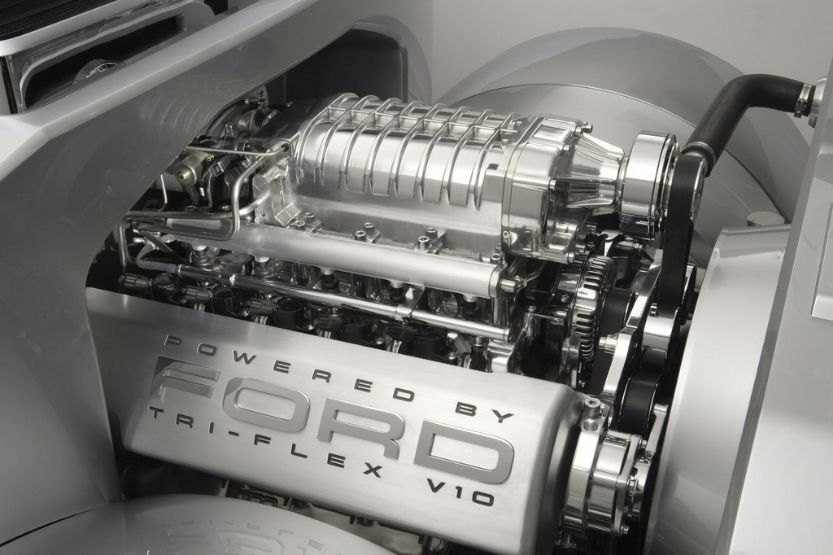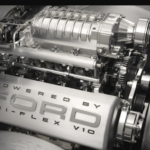The Ford V10 engine has been a part of the Ford Modular family since 1997. If you are planning on buying a Ford V10 truck, it’s important to know how long it can last? What is the Ford V10 life expectancy?
A properly maintained Ford V10 engine has a life expectancy of about 200,000 miles before requiring any major repair. The Ford V10 engine has a reputation for being reliable. This means it can be a good investment, assuming the rather poor fuel mileage does not dissuade you.
Read on to learn more about the Ford V10 life expectancy including how many miles it will last.
Ford V10 Life Expectancy

Whether you are thinking of buying a brand-new or used truck, the first thing that comes into mind is the engine’s longevity. In the case of Ford, their V10 Triton engine came with some solid engineering. Ford decided to use this modular engine in so many of their industrial vehicles already proves its durability.
People who bought Ford V10 pickups for work purposes would not settle for weak and/or fidgety engines. They need something that is up to the task, and the Ford V10 does deliver.
When you check online, you will discover that there will always be brand biases. However, it seems like there is more hate being thrown at Ford trucks. Are they substantiated, though? In the case of the Ford V10, it does not seem to be that way. In fact, you will find it hard to find people who vehemently despise the engine.
How Many Miles Will the Ford V10 Last?
Determining the lifespan of an engine can be difficult. There is no registry or database of the different brands and makes of engines and their lifespan on average. With the Ford V10, all the information is on reports made by owners and mechanics on their experiences with it.
This may not seem very accurate, but the information can be quite dependable. You can always count on car owners to warn others if they had bad experiences with a certain car or engine.
If you check out any of the Ford online forums, you will find countless reports of owners of Ford V10s not having even a single serious problem with their vehicles. Many of them report that they have reached the 200k mark on the odometer without any major repairs other than changing a couple of hoses.
Some Triton V10 owners even said they clocked over 400k on their engines. It is something that only diesel engines used to get.
Proper Maintenance Is the Key
If you properly maintain your V10, there is no reason it would not reach at least 200k miles. The keyword here is “proper maintenance.” This means you need to change the oil regularly. It is also important to change the other consumables, like transmission fluid, sparkplugs, and others, on their proper schedules.
Remember that just because one Ford V10 owner managed to get to 250k miles without any serious problems, that does not necessarily mean you will get similar results. Owners treat their vehicles differently. Some give more TLC than others. No two car owners are exactly alike, from the level of use and abuse to their maintenance schedules.
If you are thinking of getting a secondhand V10, check their maintenance history. A high-mileage but well-maintained truck is significantly better than one with low mileage but poor maintenance history.
With that, coming up with an exact number about the Ford V10 life expectancy is near impossible. Trucks are not created equal. There will always be some that are better than others.
Is the Vortec 5.3 an LS Motor?
About the Ford V10 Triton Engine

Ford first introduced their V10 engine in 1997 for their E-series vans and the motorhomes that use their chassis. Ford just added two more cylinders to the modular V8 engine that was introduced in that same year.
The Ford modular engines have been in production since 1991. When it came time to release the V10, Ford already knew all there is to know about this type of engine. They might have even perfected the technology by then, though there were still a couple of understandable kinks.
The first version of the Ford V10 had two valves, and this design persisted until 2005. After the engine made its debut under the hood of the Ford E-series, the Triton engine made its way into the F-series trucks – from the F250 up to the F550. The V10 was also used to power the Excursion SUV.
This engine was a real powerhouse. It can produce between 305 to 310 horsepower naturally aspirated. It can also crank out up to 425 ft-lbs of torque. This means anything running this engine has a massive towing capacity.
In 2005, Ford introduced an improved version of the V10. This time, it used 3 valves. This new and improved Triton saw a significant increase in power. It is also installed in more vehicles. Pumping out up to 365 horsepower and 460 ft-lbs of torque, the newer V10 had more than enough power that Ford dropped it into the F750 and even in the Blue Bird school bus.
Ford V10 Advantages
Obviously, you will be getting quite a few benefits from a vehicle powered by a Ford V10 engine, namely:
1. Cost
It might be the somewhat dismal fuel efficiency or just because only a few people know about this engine’s reliability. You will find that Ford pickups with Ford V10 engines are selling for thousands of dollars less than diesel trucks with relatively similar performance.
Also, because most truck shoppers are in the market for diesel pickups, it will be easier to find Ford V10s in secondhand car lots. If you want a utilitarian truck that can work as hard but does not cost as much as diesel, then you need to get a Ford V10.
2. Gasoline-powered
If you like the familiarity of a gasoline engine rather than switch over to diesel while ensuring it has a lot of torque for towing, you need to check out the Ford V10.
Between 2005 to 2010, Ford’s Super Duty V10 can pump out 362 horsepower and 457 ft-lbs of torque. Admittedly, that is not quite as impressive as the amount of torque that most diesel trucks can produce. Still, that is quite powerful for a gas engine. Even newer F350s with their modern V8 engines cannot even get close to it.
3. It’s a V10
Just hearing the word “V10” is enough to let you know just how cool your truck is. Do a quick online search for what other vehicles come packaged with a V10 powerplant, and you will find a long list of exotic supercars. This is where you know that you are in good company.
And one of the biggest advantages is the Ford V10 life expectancy. Again, what is the Ford V10 life expectancy? The Ford V10 life expectancy is about 200,000 miles. The Ford V10 engine has a reputation for being reliable. It is a good investment, assuming the rather poor fuel mileage is not a big concern.
Ford V10 Disadvantages

Now, the Ford V10 is far from being the perfect engine out there. It has several minor flaws that you need to be aware of, so you won’t be caught by surprise later. Here are some of the more common concerns that Ford V10 owners had to face:
1. Not so Fast and Furious
Even though you are sitting behind a V10 engine, it is a bit lacking in the speed department. The Ford V10 was built with heavy-duty towing in mind, hence the high torque output. It means it does not like going fast.
2. Poor Fuel Economy
Although no one expects that the Ford V10 will have Prius-level fuel economy, it still ranks low in its class when it comes to miles-per-gallon. The Ford V10 gets, at most, 10 miles per gallon. It is worse than the infamous Hummer H2, which can get up to 12 miles per gallon.
Compare these engines to diesel engines, and you will notice a very stark difference. Even the worst-performing diesel engines, on average, get 3 to 6 more mpg than the Ford V10.
Undeniably, the Ford V10 guzzles gasoline like there is no tomorrow. With that, expect more frequent trips to the gas pump in the future.
3. Cracked PCV Hose
The Ford V10, like all modern gasoline engines, has a system for recirculating gases inside the crankcase called the Positive Crankcase Ventilation (PCV). When the engine burns gasoline, it creates exhaust gases.
While most of these gases go through the exhaust system, some remain inside the engine. The PCV is responsible for recirculating these gases back into the intake manifold so the engine can burn them again.
When the PCV releases the trapped exhaust gasses back into the manifold, they go through the PCV hose. Now, the problem here is that the PCV hose in the Ford V10 is made of plastic. And plastic is prone to cracking after a while. When the hose inevitably cracks, it causes a drop in pressure in the intake manifold.
This leads to the air leaking out, causing various problems, like:
- Rough idling, a common complaint with the Ford V10
- Whistling or hissing from the engine
- Misfiring cylinders
- Fuel economy dropping even more
4. Exhaust Problems
Another common problem with the Ford V10 is with the exhaust system. Many owners complained that the studs connecting the exhaust pipe to the manifold rusted out. It caused exhaust fumes to leak out, sometimes getting inside the cabin.
Fortunately, you can find repair kits for this problem, and it will only cost you around $30. On the other hand, if you do not have jack stands at home, you can take your truck to your local mechanic and let the professionals do it. They would take less than half an hour, so it will still be a cheap repair job either way.
5. Spark Plug Blowout
Although most of the Ford V10 issues are quite minor, there is one serious problem with pre-2002 models. These engines have a serious design flaw inside the cylinder head that causes the spark plugs to either jettison themselves out or weld themselves onto it.
The first Ford V10 engines had cast-iron engine blocks and aluminum cylinder heads with center-mounted spark plugs. The problem is that the spark plugs are made of steel. This material has a significantly different heat tolerance compared to the aluminum cylinder head.
The major issue is with the holes for the spark plugs in the cylinder head. Because the holes were only five inches deep, the Ford V10 needed to use extremely short spark plugs to fit into their respective cylinder head wells.
Ford shortened the length of the threads to just four to make up for the shallow depth of the wells. The average spark plug has at least 10 threads. Meaning the spark plugs were barely holding in place in the first place.
Because of the great differences between heat tolerances between the cylinder heads and the spark plugs, their threads would essentially fuse into the head. When this happens, there are only two things that can happen:
- You will not be able to remove the spark plugs when it comes time to replace them – The reason is that they are welded onto the cylinder head.
- Because of the enormous heat that caused the spark plug to weld onto the cylinder head, the steel becomes brittle – which can cause the plug to blow out of its seating.
However, even if it seems like an expensive repair job, you will only need to re-thread the cylinder head to accept a new spark plug.
Conclusion – Ford V10 Life Expectancy
A Ford V10 can reliably work for more than 200,000 miles without needing any major repairs if you take good care of it. The only real downside to owning one is the rather poor fuel economy. However, if that is not an issue with you, then the Ford V10 is an incredible option.
It is indeed a fantastic investment, especially if you also want a powerful, durable, and reliable gasoline-powered truck.
Related reading:
2.2 Ecotec Engine [Specs, Features, and Problems]
Ford 6.2 Engine Problems [5 Most Common and How to Fix]
5.0 Coyote F150 Reliability [How Reliable Is This Ford Engine?]




![Are BMWs Good Cars? [Reliability, Problems, Life Expectancy] are bmws good cars](https://roadsumo.com/wp-content/uploads/2022/04/are-BMWs-good-cars-150x150.jpg)
![Toyota Long Life Coolant and Super Long Life Coolant [Review] toyota long life coolant](https://roadsumo.com/wp-content/uploads/2021/07/toyota-long-life-coolant-150x150.jpg)



![Read more about the article 5.0 Coyote F150 Reliability [How Reliable Is This Ford Engine?]](https://roadsumo.com/wp-content/uploads/2021/06/5.0-coyote-f150-reliability-300x200.jpg)